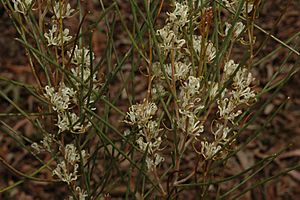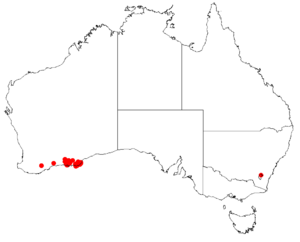Hakea adnata facts for kids
Quick facts for kids Hakea adnata |
|
|---|---|
 |
|
| Hakea adnata in the ANBG | |
| Scientific classification | |
| Genus: |
Hakea
|
| Species: |
adnata
|
 |
|
| Occurrence data from Australasian Virtual Herbarium | |
Hakea adnata is a cool shrub that grows in Western Australia. It's part of the Proteaceae plant family. This plant is special because it has many stems and beautiful, sweet-smelling white flowers. These flowers bloom from late winter into spring, making the plant look amazing!
What Does Hakea adnata Look Like?
Hakea adnata is an upright, broom-like shrub. It can grow from about 1 to 3.5 meters (3 to 11.5 feet) tall. Its smaller branches and new leaves often have a rusty color.
The leaves are dark green and look like needles. They can be straight or slightly curved, measuring about 2.5 to 13 centimeters (1 to 5 inches) long. Each leaf has a small hook at its tip.
This plant produces 2 to 6 sweetly scented white flowers in clusters where the leaves meet the stem. The flowers have a silky white fuzz on their lower parts. The main part of the flower is about 4.5 to 5.5 millimeters long, and the style (a part of the flower) is about 7.5 to 10 millimeters long.
After flowering, large, egg-shaped fruits appear. They stand upright or slightly tilted on their stalks. These fruits are about 2.5 to 3.8 centimeters (1 to 1.5 inches) long and 2 to 3 centimeters (0.8 to 1.2 inches) wide. They have a smooth or slightly rough surface and a short, upturned "beak." Inside, the seeds are about 1.6 to 2.3 centimeters (0.6 to 0.9 inches) long. Hakea adnata flowers from July to October.
How Hakea adnata Got Its Name
Hakea adnata was first officially described by a botanist named Robert Brown in 1830. He published his description in a book called Supplementum primum Prodromi florae Novae Hollandiae. For a while, it was also known by another name, Hakea lativalvis, but Hakea adnata is the correct one now.
The second part of its name, adnata, comes from a Latin word meaning "united with." It's a bit of a mystery why this name was chosen, as Robert Brown didn't explain it in his original description!
Where Does Hakea adnata Grow?
Hakea adnata is found in different spots along the south coast of Western Australia. Most of these plants grow between the towns of Norseman and Esperance, and also in Cape Arid National Park.
You can find Hakea adnata growing on flat areas and near salt lakes. It likes sandy clay and gravelly sandy soils. It often grows as part of plant communities that include Banksia speciosa or other types of shrubs and small trees.

